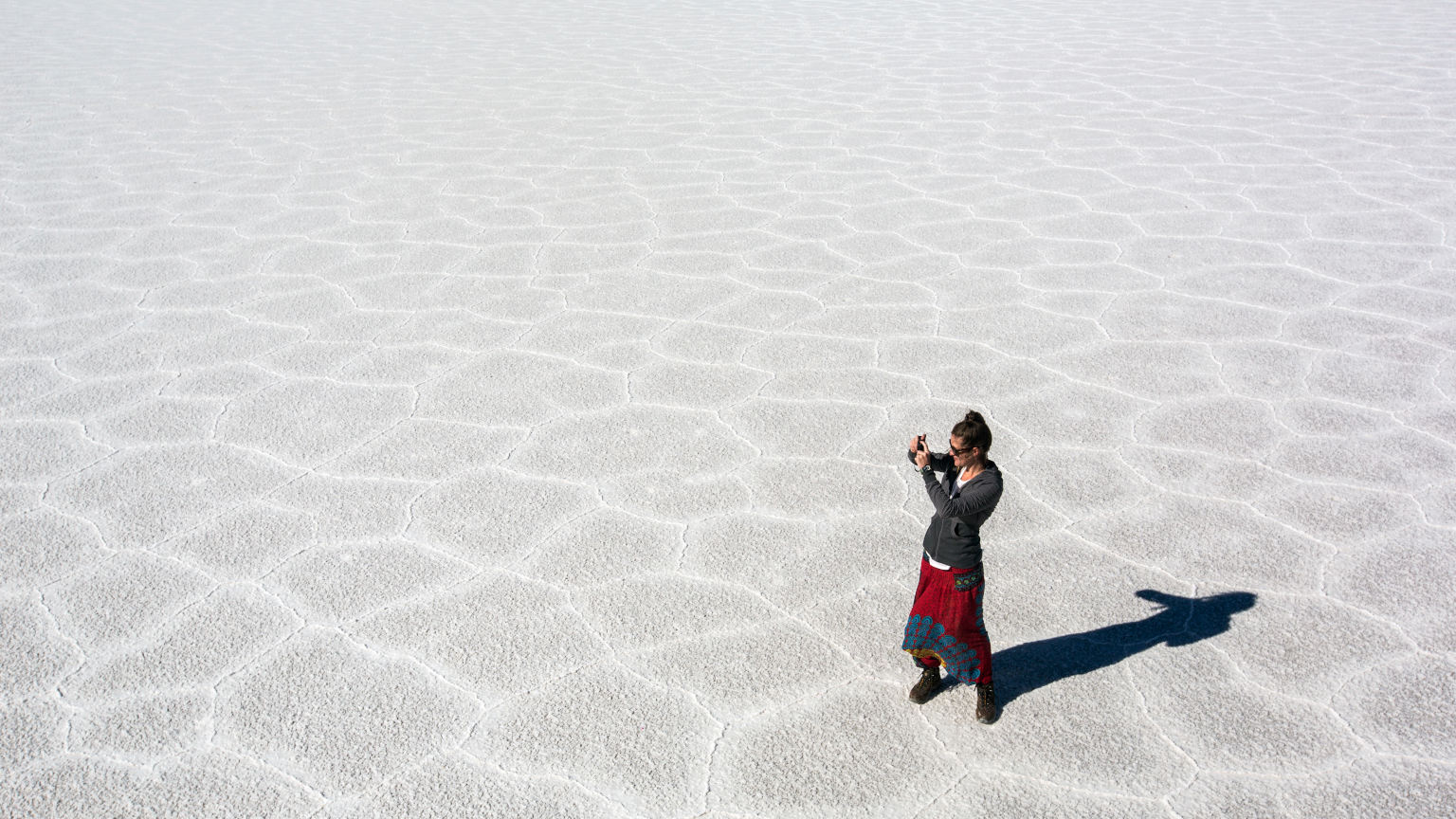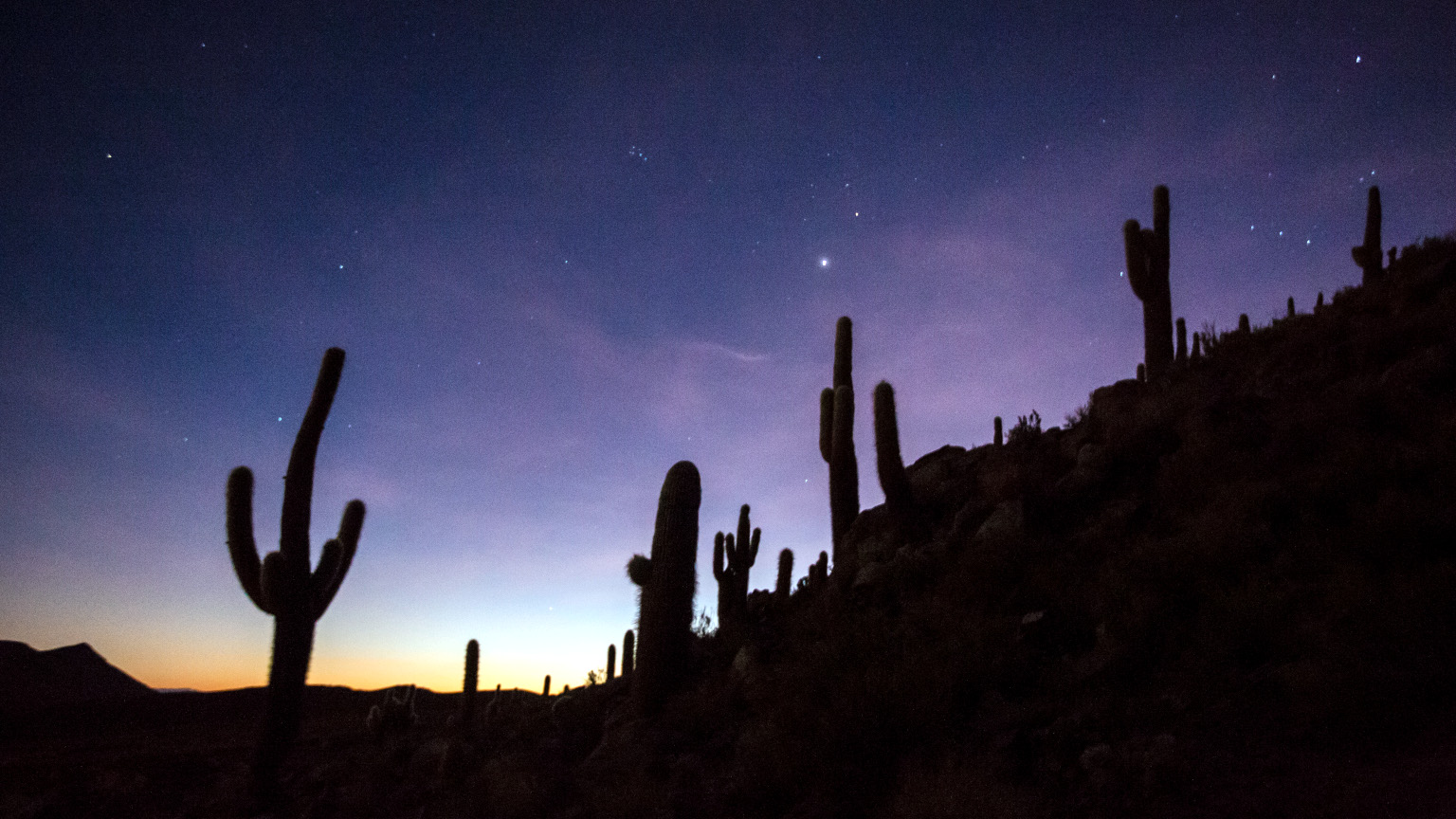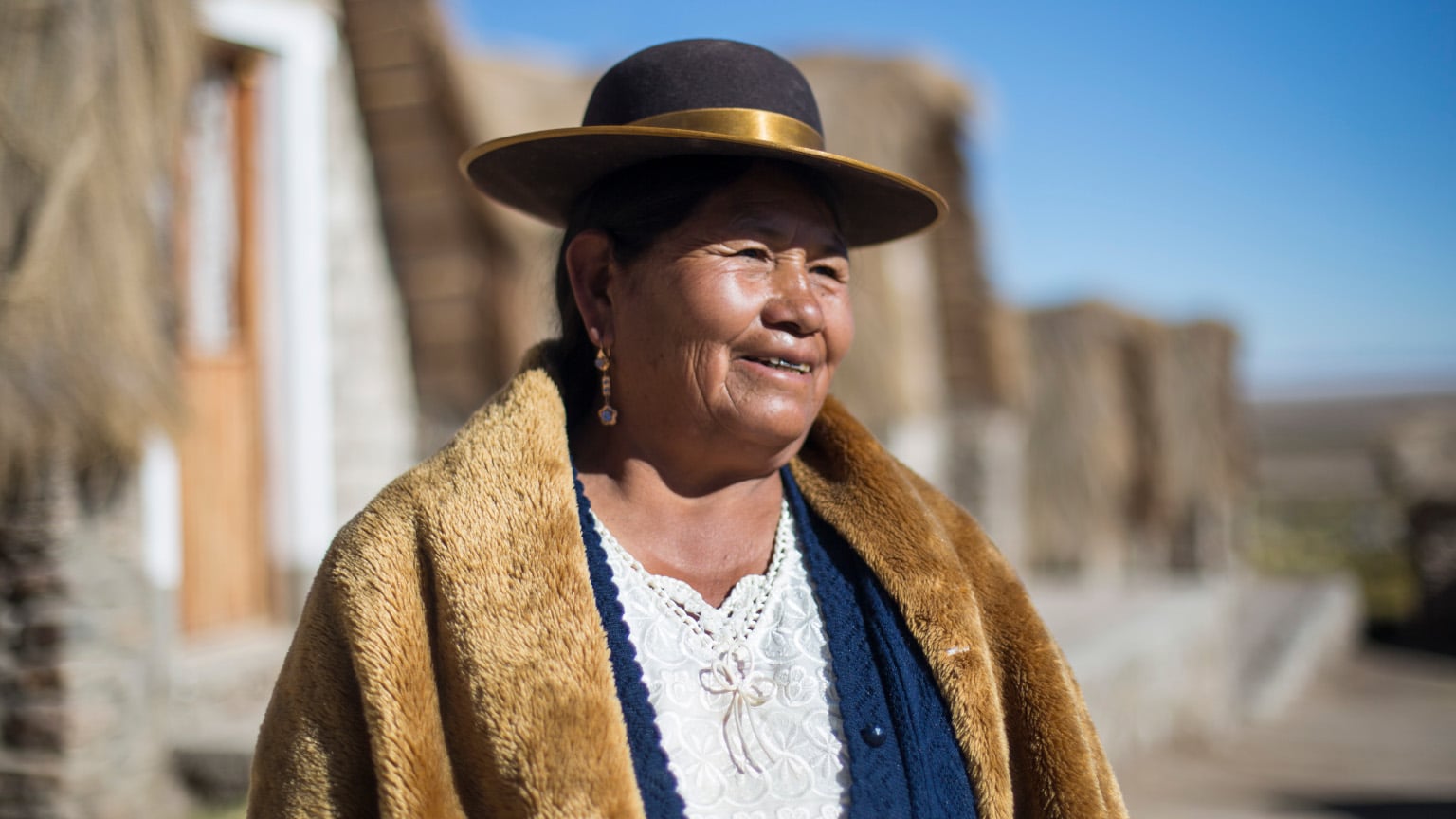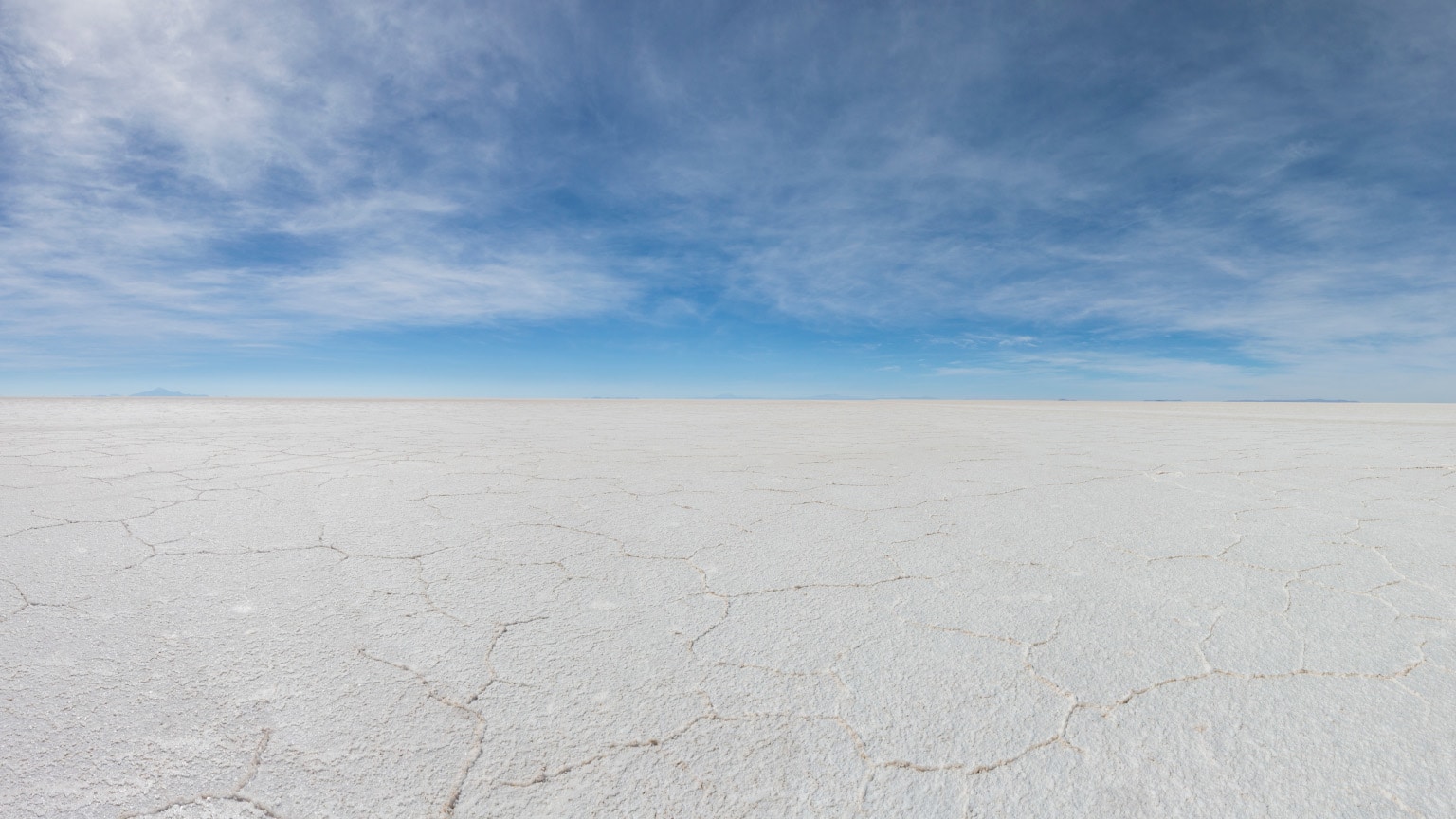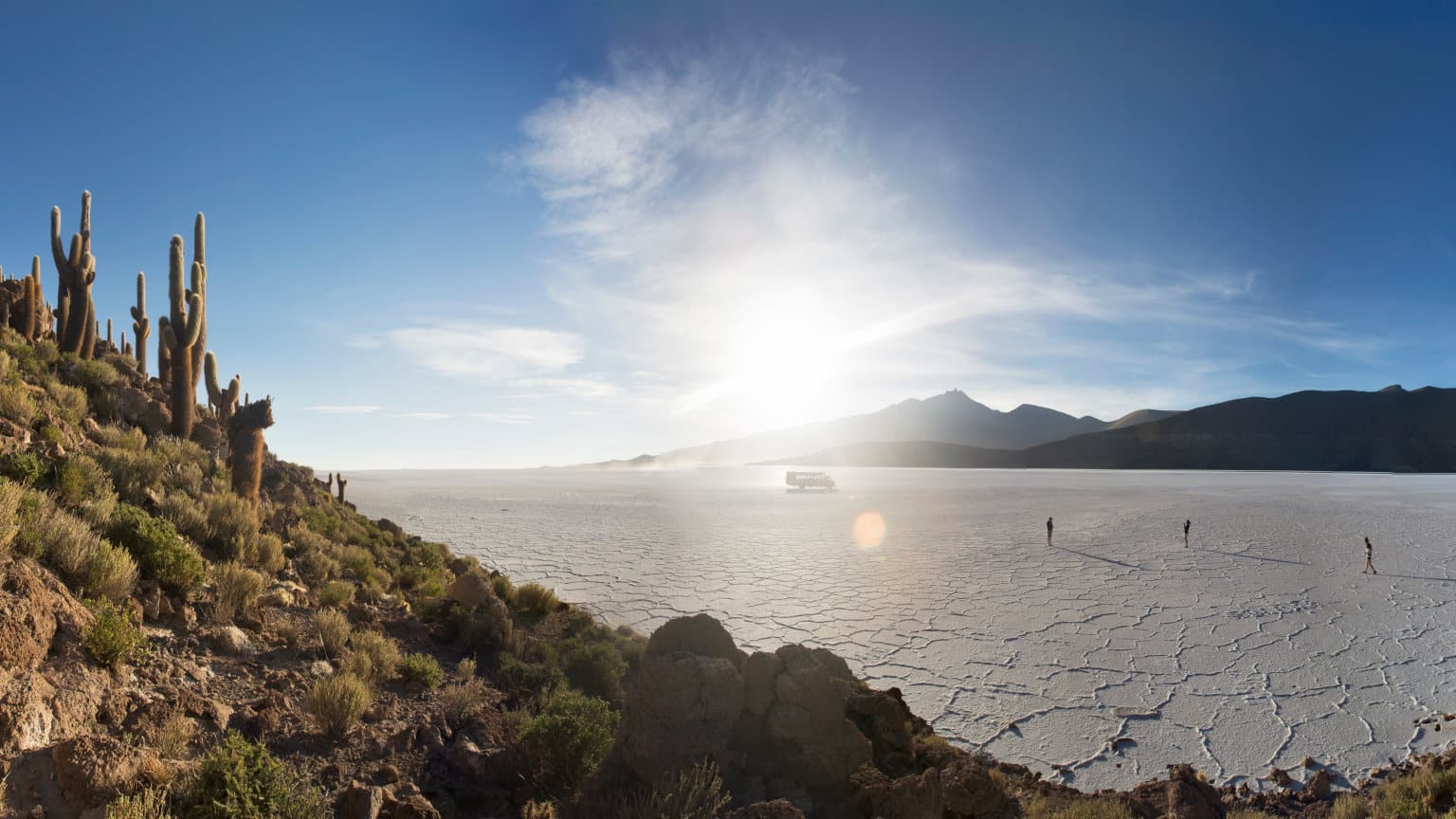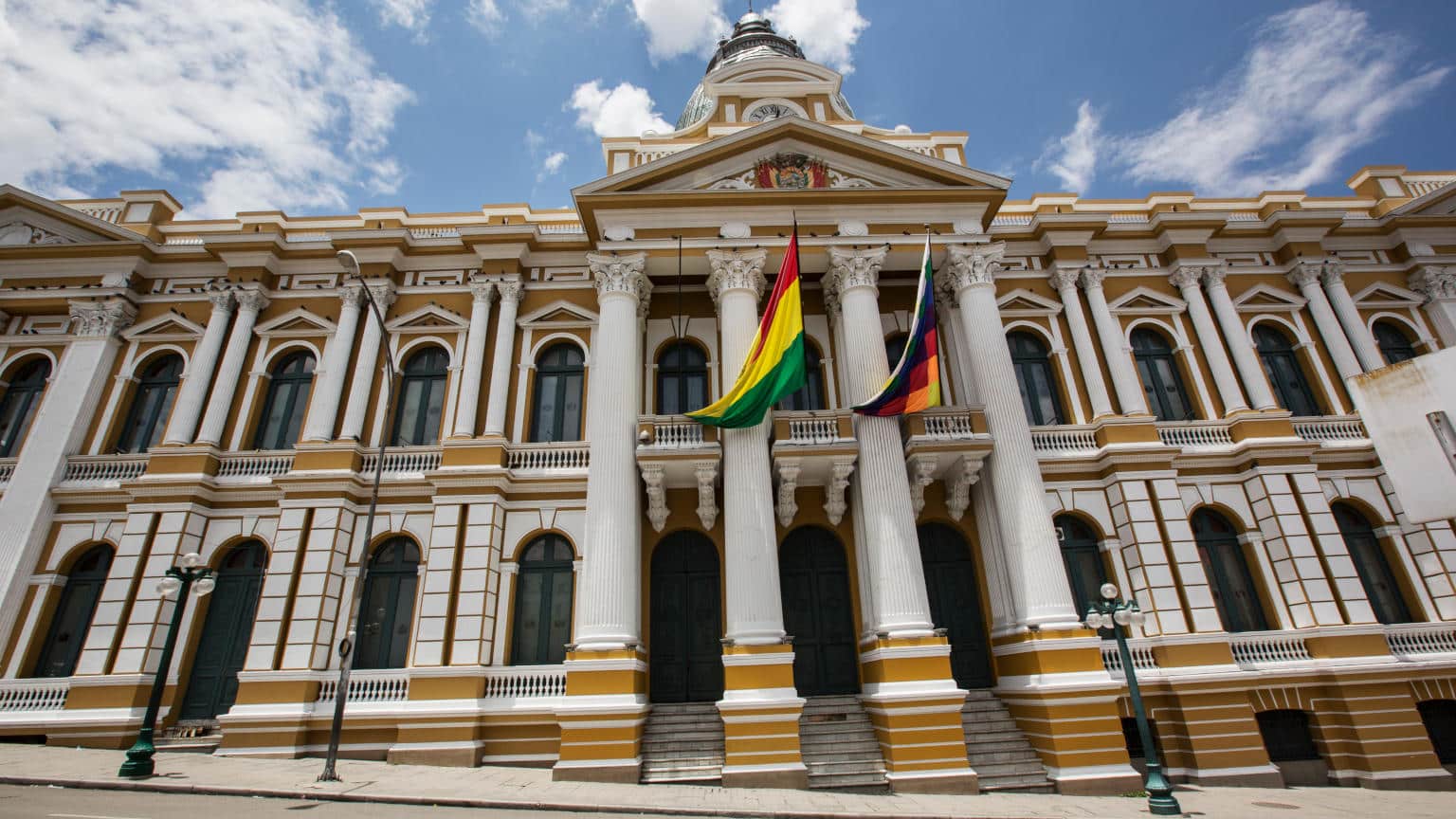Price
 $1949
$1949
Overview
Embark on an adventure in Bolivia, where awe-inspiring landscapes, rich colonial history, and vibrant indigenous culture await. From the bustling streets of La Paz, the highest capital city in the world, travel through the Andes to the Uyuni Salt Flats, where the surreal beauty of the surrounding desert altiplano makes for an unforgettable 4x4 excursion. Engage with locals, learn about their traditions, and witness the profound impact of sustainable tourism. Uncover hidden treasures in Potosí and explore bustling markets. Take the road less traveled in Bolivia for an authentic and unforgettable experience, all while earning professional development credit with other educators.
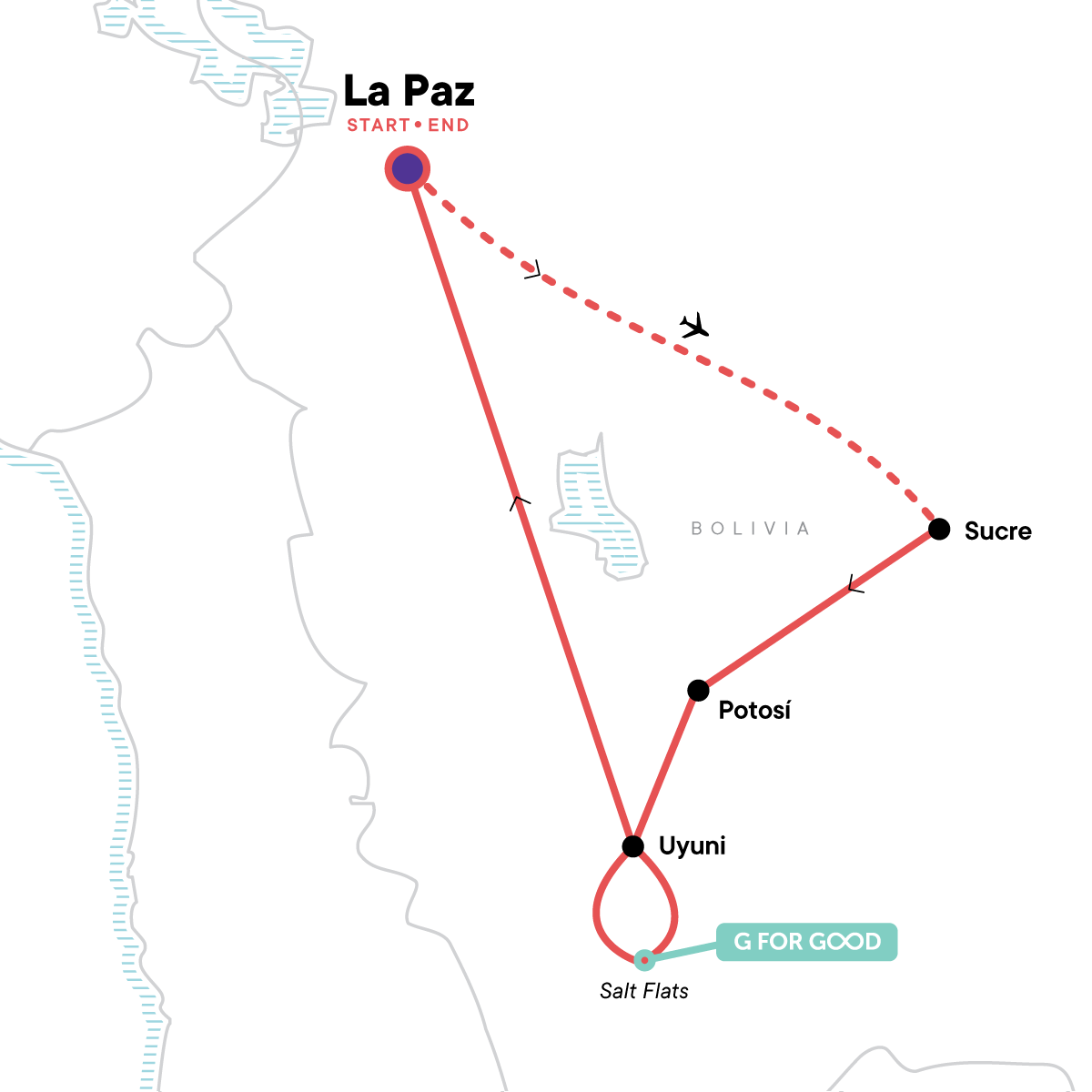
What's Included:
- Jukil Community Experience & Lodge, Santiago de Agencha
- 4x4 excursion to the Uyuni Salt Flats (3 days)
- Internal flight
- G Adventures Tour Leader throughout, local guides
- 10 breakfasts, 3 lunches, 2 dinners – allow $260-340 USD for meals not included
- Hotels (7 nts), G Adventures-supported lodge/basic hotels on Salar de Uyuni excursion (2 nts, multi-share), overnight bus (1 nt)
- All transport between destinations and to/from included activities using train, private vehicle, night bus, 4x4 vehicle, and plane
What's Not Included:
- International air travel
- Incidentals
- Travel health and cancellation insurance
- Applicable visas
- Tips or gratuities
- Airport taxes
- Beverages
- Meals not mentioned in itinerary
- Optional tours and admissions
- Airport transfers
Itinerary Download PDF
Arrive at any time. This tour begins and ends in La Paz, and the nearest airport is El Alto International Airport (LPB). Due to the potential for flight delays or cancellations, we recommend that you plan to arrive in South America at least a day in advance. This will also give you time to rest and adjust to any time difference. We can book extra hotel nights for you in La Paz before and/or after the trip. Please note that check-in at the hotel is usually around 2:00-3:00 p.m. There are no planned activities until an intro meeting around 6:00 or 7:00 p.m., usually in the hotel lobby. Check for a sign or ask at the reception desk about the exact time and location of the group meeting. Please make every effort to arrive in time for this meeting. If you are delayed and will arrive late, please inform us. Your tour leader will then leave you a message at the front desk informing you of where and when to meet up tomorrow. After the meeting, you might choose to get dinner at a nearby restaurant with your traveling companions and your tour leader to further get to know one another. La Paz, which lies between 10,650 and 13,250 feet above sea level, is the world’s highest national capital. We recommend taking it easy for the first 24 hours, as physical activity can exacerbate symptoms of altitude sickness. See our optional activities list further below for suggested activities in La Paz. Accommodation: Hotel Las Brisas (or similar) * For the actual hotel your specific departure will be using, please check your voucher.
This morning, you are free to explore La Paz before boarding an afternoon flight to Sucre. Once in Sucre, you might choose to explore the beautiful colonial city or go hiking in the surrounding area. See our optional activities list below for other suggested activities in Sucre. Sucre is considered Bolivia’s most beautiful city and the symbolic heart of the nation. It was here that independence from Spain was first proclaimed. While La Paz is now the seat of the federal government and treasury, Sucre is recognized in the constitution as the nation’s capital. Approximate travel time: 1 hr by plane Accommodation: Hotel Independencia (or similar) Meals included: Breakfast
There's plenty to see and do in Sucre, and we want to make sure that you had some time to take it all in. Today, feel free to relax or try optional activities like hiking, mountain biking, or visiting the Textile Cooperative. Your tour leader has more ideas if you need them. Just ask! You might enjoy a visit to the Tarabuco market where indigenous groups from the surrounding area gather every Sunday to sell their goods. It offers a glimpse into daily Bolivian life and the diversity of its people. Accommodation: Hotel Independencia (or similar) Meals included: Breakfast
Today is another free day for you to explore Sucre. Perhaps you'll choose to go on an excursion to see dinosaur tracks! Or maybe stroll through the Tarabuco market to catch a glimpse of daily Bolivian life. Feeling adventurous? Embark on a hike through the scenic area or maybe book a mountain biking experience. If you’re hungry, grab a salteña, which is a juicy, sweet-doughed, empanada-like snack. Check out our recommendations for optional activities further below. Accommodation: Hotel Independencia (or similar) Meals included: Breakfast
Today, we journey from Sucre to Potosí, where you will spend the afternoon exploring the city. Opt to go on a silver mine tour or check out the National Mint museum. Potosí’s story is tied to its silver. During the boom years, when the country was still a part of the Spanish Empire, the metal must have seemed inexhaustible. It became the largest and wealthiest city in the Americas, which you can still see evidenced by its grand cathedrals and ornate colonial architecture. Despite this colonial prosperity, working conditions for miners were appalling, and the indigenous population was decimated. African slaves were brought in to replace the native workers, and it is estimated that as many as 8 million indigenous and African people died in the mines during the first three centuries of Spanish colonial rule. Once the silver ores were depleted, the city fell into decline and its citizens slipped into poverty. Silver ore, along with tin, lead, and other metals, is still extracted by miners today. Unfortunately, little has changed about the miners' working conditions over time. While not for everyone, we do recommend an optional tour of the mines as an eye-opening experience that gives you a chance to glimpse the realities of life in the Andes in general, and more specifically in the mines. Please note, we do not condone the working conditions of the mine. Approximate travel time: 3 hrs by private vehicle Accommodation: Hotel Gran Libertador (or similar) Meals included: Breakfast
Today, we head south to Uyuni, the starting point for an excursion to the Uyuni Salt Flats. The area is cold and windy, especially at night, so be prepared to put on a warm coat. Despite its geographic isolation and challenging climate (cold and blustery most of the year), the town of Uyuni has earned the nickname of Hija Predilecta de Bolivia (Bolivia’s Favorite Daughter). Founded in 1889, Uyuni occupies a desolate corner of southwestern Bolivia. It has an important military base, and most jobs in the town are focused on the tourism and mining industries. The world’s largest lithium reserve—about 100 million tons—lies beneath the neighboring salt flat and could potentially fuel all the smartphones and electric cars that the world will build over the next century. Approximate travel time: 4 hrs by private vehicle Accommodation: Hotel Samay Wasi (or similar) Meals included: Breakfast
Today is the first of three days spent in the stunning landscape between the Salar de Uyuni and the Atacama Desert in Chile. We will enter a world unlike anything else as we take 4x4 vehicles across the salt flats, where the piercing blue sky contrasts with the blinding white of the flat salt beds. You will have plenty of opportunities to take memorable photos of the unusual landscape, which includes mountains, active volcanoes, geysers, and boiling mud pools. We will stop by the red lagoon of Laguna Colorada. We will also visit the Santiago de Agencha community, located two hours across the salt flats from Uyuni. The rural village is surrounded by towering cacti and is part of a small desert oasis. The community-owned salt lodge was renovated and expanded through a major project in 2016 funded by the Planeterra Foundation. With many of the village’s younger residents leaving for economic opportunities elsewhere, the lodge is a way for the community to generate income, provide opportunities for the future, and preserve their indigenous culture. While at the lodge, learn about traditional agricultural practices, including their specialization in quinoa production, and take a guided walk with a community member to the sacred Jukil mountaintop for a beautiful view of the village below and the salt flats beyond. Meals of local ingredients grown in the village are prepared by women who received culinary training through the Planeterra project. In the evening, settle into your salt-brick bungalow, complete with salt floors and furniture. Accommodation: Jukil Lodge (or similar) Meals included: Breakfast | Lunch | Dinner
Depart the Jukil Community Lodge knowing your visit helped to create opportunities for a whole new generation of people in this community. We will spend the day continuing to explore the Uyuni Salt Flats on a 4x4 excursion. Accommodation: Laguna Colorada Lodging (or similar) Meals included: Breakfast | Lunch | Dinner
This will be our final day on the Uyuni Salt Flats before we board an overnight bus back to La Paz. Approximate travel time: 8 hrs by night bus Accommodation: Overnight Bus Meals included: Breakfast | Lunch
Our final full day in Bolivia is a free day to explore La Paz some more. Thrill seekers might opt to bike the famous "death road" (North Yungas Road). In 1994, the Inter-American Development Bank dubbed it the "most dangerous road in the world." People risk their well-being to travel the road because of the spectacular views, with stunning panoramas from the mountainside and across the Amazon canopy. For safety reasons, it is important to use a reputable tour guide/company. Alternatively, you might opt to visit the Witches' Market or take one of several other optional excursions in La Paz. Walk along the winding streets, shop in the markets, and enjoy the nightlife. Accommodation: Hotel Las Brisas (or similar) Meals included: Breakfast
There are no planned activities today, so you may depart La Paz at any time. If you wish to extend your stay in La Paz, consider booking post-tour accommodation with us. Please note that check-out time from the hotel is usually mid-morning, but luggage storage services are available at the reception desk. Want more adventure? Book two or more GEEO programs in the same school year and receive a discount! GEEO will give you 10% off of the lesser value program(s) (up to 3 programs per year). If you would like to extend your time abroad but don't see another GEEO program that interests you, let us know. We can work with you to find a trip from our tour operator’s much larger catalog. Their tours are open to the general public and not designed specifically for educators, but we can still offer you and your travel companions a discounted educator price on any additional tours that you book. Meals included: Breakfast
*Itinerary Disclaimer: While it is our intention to adhere to the routes described on our website, there is a certain amount of flexibility built into the itinerary and on occasion it may be necessary, or desirable, to make alterations. The itinerary is brief, as we never know exactly where our journey will take us. Due to our style of travel and the regions we visit, travel can be unpredictable. The information on our website is a general guide to the tour and region, and any mention of specific destinations or wildlife is by no means a guarantee that they will be visited or encountered. Additionally, any travel times listed are approximations only and subject to vary due to local circumstances.
Details
Frequently Asked Questions
Please read our general FAQs, where you can find essential information that applies to all of our programs.Resources to Learn & Teach about Bolivia
Visit our recommended reading page to see the list of books GEEO recommends reading before your program (this is not required reading). We also have lesson plans and Pinterest boards that may be useful for you as you learn about your destination and prepare to bring lessons back to your classroom.Terms and Conditions
It is very important for you to visit our Terms and Conditions page before signing up for this program.GEEO Program Confirmation Process
We require a minimum of 6 participants for most GEEO programs. We officially confirm that a program will run once at least 8 people have signed up, which provides a margin for individual cancellations. Nearly all GEEO programs ultimately meet this enrollment quota, and in the rare event that a program does not meet the minimum requirement and GEEO cancels the program, we will work with you to find a suitable alternative or provide a refund of your deposit if you prefer. We encourage you to sign up for any program that interests you, and we will notify the entire group once 6 people are booked and again once 8 people are booked. We always emphasize the importance of exercising caution when making non-refundable travel arrangements, especially given the unpredictable nature of travel. For example, we typically recommend booking flights with flexible change/cancellation policies.Cancellation policy
All cancellations must be submitted to GEEO in written form by emailing your request for cancellation to travel@geeo.org. If you do not receive a confirmation that we have received your written cancellation request, please call us at 1-877-600-0105. Verbal cancellation requests will not be honored.- If you cancel 60 days or more prior to departure, all your program fee payments will be refunded besides your $350 deposit which is kept on file for future use
- If you cancel between 30 and 59 days prior to departure, you will receive a 50% refund and your deposit is kept on file for future use
- If you cancel within 30 days of departure, you will receive no refund, but your deposit is kept on file for future use
Trip Notes
- YELLOW FEVER: It may be required to show a Yellow Fever certificate upon entering Bolivia. Please check in with your local health expert for advice on Yellow Fever and other inoculations required for this area.
- ALTITUDE: Please note your Adventure travels to high altitude. This is medically defined as anything over 2,440 m (8,000 ft). Most people can travel to 8,000 ft with minimal effects, but everyone reacts to altitude differently, and altitude sickness can set in with some people irrespective of fitness and age. For details on how to best prepare and what to do in the unlikely event you are affected on your adventure, please consult your physician. Make sure your doctor carefully checks to make sure any medication you need is safe to use at over 11,000 feet above sea level.
- SALT FLATS: The accommodation on the salt flats are really cold at night. Make sure you pack long john bottoms and tops. They rent warm sleeping bags fairly cheaply that we recommend. Your tour leader can arrange this for you the day before. Also pack plenty of snacks as the menu is quite limited in this remote part of Bolivia.
- ACCOMMODATION NOTE: Please be aware that properties we stay in with only two stories may not have elevators installed and climbing the stairs with your luggage will be necessary
Group Leader Description
All GEEO/G Adventures group trips are accompanied by one of G Adventure’s group leaders, which they refer to as Chief Experience Officers (CEOs). The aim of the group leader is to take the hassle out of your travels and to help you have the best trip possible. They will provide information on the places you are traveling through, offer suggestions for things to do and see, recommend great local eating venues, and introduce you to our local friends. Our itineraries often have plenty of free time to explore on your own. While not being guides in the traditional sense, you can expect them to have a broad general knowledge of the countries visited on the trip, including historical, cultural, religious, and social aspects. We also use local guides where we think more specific knowledge will add to the enjoyment of the places we are visiting – we think it’s the best of both worlds.Fitness Level
Trip includes moderate hiking and other activities that require an average/moderate level of fitness to enjoy.Single Travelers
Half of GEEO’s participants travel by themselves, so please don’t worry if you do not have a travel companion for your trip. Our program fee is for one traveler in double-occupancy accommodation, and GEEO can find you a roommate of the same gender if you do not have a travel companion. Most of our programs have a “My Own Room” option, also known as a “Single Supplement,” which is an extra fee that you can pay to have a room to yourself. You will only incur an additional charge if you specifically request a single room. To see the price for the “My Own Room” option, please find your program on our extra services page. If you want to room alone, please email travel@geeo.org to request a single room. Please note: if you have booked the “My Own Room” option for this tour, you will receive your own single accommodation for all night stops except Days 7 and 8 (Salar de Uyuni - multi-share) and Day 9 (overnight bus).Joining Instructions
Day 1 is an arrival day, and no activities have been planned. Upon arrival to the city on Day 1, or earlier if you have booked pre-accommodation with us, please make your way to the joining hotel. Please note: Check-in time will be in the afternoon. Once you arrive at the hotel, look for a note at reception from your tour leader. This note will give the details of your Welcome Meeting on Day 1, usually between 6:00 p.m. and 7:00 p.m., during which you will get a chance to meet your tour leader and other travelers, as well as learn more about how the tour will run. If you don’t see a note, please ask reception for details. If you miss the Welcome Meeting, your tour leader will leave a note at reception for you with any information you may need and with instructions for the next morning. The easiest way to get from Alto International Airport to the center of La Paz, where the hotel is located, is via taxi, and the drive is spectacular. You can order a taxi (approximately $8 USD) from an official uniformed taxi driver. The trip takes approximately 30 minutes and is very scenic. The money exchange desk at the airport is open 9:00 a.m. to 7:00 p.m.Emergency Contacts
Should you need to contact G Adventures during a situation of dire need, it is best to first call their local office. If for any reason you do not receive an immediate answer, please leave a detailed message and contact information, so that they may return your call and assist you as soon as possible. EMERGENCY CONTACT NUMBERS G Adventures Office Lima, Peru During office hours (Weekdays, 9-6pm Local Time): +51 1 241 1650 After hours Emergency number: +51 99 758 2712 (WhatsApp Available) If for any reason you are unable to reach the G Adventures local office, please call the numbers listed below to connect with their Sales team, who will happily assist you. Toll-free, North America only: 1 888 800 4100 Calls from UK: 0344 272 0000 Calls from Germany: 0800 365 1000 Calls from Australia: 1 300 796 618 Calls from New Zealand: 0800 333 307 Outside North America, Australia, New Zealand, Germany and the UK: +1 416 260 0999Packing List
Please read this article on GEEO’s blog for our staff’s suggestions on the best gear to pack for your upcoming travels. You must be prepared to carry your own bags and be comfortable carrying them up and down stairs, on and off transportation, and to hotels. As a rule, we try not to have to walk more than 15-20 minutes with your bags, which is why we recommend keeping the weight of your bags between 22-30 lb. Most travelers carry a backpack or rolling bag of small to medium size. No XXL bags please! A daypack is also essential for carrying everyday items. Space is limited on transportation, so there is a limit of one main piece of luggage per person plus a daypack per person. Health & Safety- N95/KN95 Face masks (at least a few just in case there is an outbreak within your group)
- Hand sanitizer
- Quick Covid Test/Antigen Tests (at least 3)
- 4-season sleeping bag and liner – also available for rent for about $5 per day
- Winter hat and gloves
- Warm jacket
- Windproof/waterproof rain jacket
- Personal clothing for cold to warm weather – we recommend packing 7-8 days of outfits, so you only have to do laundry once
- Fleece or down top – it gets down into the 20’s at night in the Andes!
- Light hiking boots or sturdy walking shoes
- Daypack
- Sunblock
- Sunglasses
- Sun hat
- Watch or alarm clock
- Small flashlight
- Toiletries
- Camera
- First-aid kit, including lip salve, aspirin, bandaids, anti-histamine, Dramamine, Imodium or similar tablets for mild cases of diarrhea, electrolyte powder, insect repellent, extra prescription drugs you may be taking
- Bathing suit and small, quick-dry towel
- Binoculars
- Travel pillow
- Water bottle
- Money belt
- Phone/tablet for internet – most hotels have WiFi
- Chargers for electronics as well as converters/adapters, if needed
- AirTags or Tile trackers
- Packing cubes
- Flip-flops/sandals
- Earplugs
- Snacks – packing a few granola bars is a good idea; you can buy snacks when you get there too, so don’t go crazy here
- Ziplock bags
- Reading/writing material
- Hand sanitizer/baby wipes
- Passport (with photocopies)
- Any entry visas or vaccination certificates required
- Travel insurance ID card
- Flight itinerary/boarding pass(es)
- USD/EUR cash
- Credit/debit card
- G Adventures vouchers
- GEEO Classroom action plans for your group – this is sent a few days before departure
Laundry
Laundry facilities are offered by some of our hotels for a charge, or you can ask your tour leader where the nearest laundromat is located. There will be times when you may want to do your own laundry, so we suggest you bring non-polluting/biodegradable soap.Passports and Visas
All GEEO trips require that the participant have a valid passport. Please see our general FAQ for information on obtaining a passport. As with all of our trips, we try to provide the most accurate information we can, but governments sometimes change visa rules. It is your responsibility to double check the information we provide below by searching here. U.S. citizens need a visa to travel to Bolivia. The visa is available upon arrival for $160 USD. IMPORTANT: U.S. dollar bills must be in perfect condition. Old, torn, or marked notes will not be accepted by immigration officials. It is possible to apply for a visa online in advance, but you will likely spend more time and effort applying online than you would receiving one at the airport upon arrival. To apply for a visa, U.S. citizens must submit:- 6-month validity remaining on passport
- Passport photo
- Evidence of a hotel reservation (your G Adventures confirmation voucher)
- A copy of your trip itinerary
- Proof of economic solvency (e.g., a current bank statement)
- Sworn Statement form
Money Exchange
The local currency in Bolivia is the Bolivian boliviano (BOB). As currency exchange rates fluctuate, we ask that you refer to the following website for daily exchange rates: www.xe.com. We recommend that you obtain cash from ATMs while traveling; they will dispense the local currency. We do, however, recommend that you bring at least $200 USD in cash for emergency use or in case you have trouble with the ATMs. Major credit cards are accepted in most shops, but you may be charged an international transaction fee; ask your financial institution about their international fees. Please note that if you are carrying U.S. dollars, the bills should be in good condition (i.e., not torn, wrinkled, or marked on in any way) and dated recently.Tipping
It is customary in Latin America to tip service providers such as waiters, at approximately 10%, depending on the service. Tipping is an expected, though not compulsory, component of this program and an expression of satisfaction with the people who assist you on your trip. Tipping is also one of the most direct ways that you can have a positive economic impact within the local community. Although it may not be customary to you, it is of considerable significance to the people who will take care of you during your travels. There will be opportunities during the trip to tip your local guides or drivers. You may do this individually, or your tour leader may offer to collect the money and give a tip on behalf of the group. Recommendations for tipping local guides and drivers range from $5-10 USD per person per day, depending on the quality and length of the service. Ask your tour leader for specific recommendations based on the circumstances and expectations. Also, at the end of your program, if you felt your G Adventures tour leader did an outstanding job, a tip would be appreciated. The amount is entirely your personal preference, but as a guideline, $20-25 USD per person per week would be appropriate.Vaccinations
GEEO cannot provide any medical advice, so it is very important to consult your doctor or a travel clinic about which vaccinations you will need for your trip. We recommend contacting Passport Health (http://www.passporthealthusa.com/), which has travel clinics located throughout the United States. You can also check the CDC's recommended vaccinations for your destination. Please take this seriously!Flights
We find the best prices for flights are often available around 90 days before departure, but of course this varies greatly from route to route and year to year. You should wait until this trip is confirmed before you book non-refundable flights. GEEO and G Adventures bear no responsibility for any flights purchased before the trip is confirmed. This program begins and ends in La Paz. Please double-check our itinerary for the date by which you must arrive in La Paz. You may want to arrive in La Paz one or more days early in case you have flight disruptions. You can arrive at any time you choose, but try to make it in time for our 6:00 p.m. Welcome Meeting on Day 1. You can depart from La Paz any time on the final day of the program.Plugs and Converters
There are two components to provide external power to your device: adapters and transformers (also called electrical converters). The adapter is for your device's plug, adapting the prongs on a standard U.S. two- to three-pronged power cord to fit the local outlets. The transformer/converter changes the local voltage to the voltage used in the U.S. Bolivia uses 2- and 3-pronged power plugs similar to those in the United States, as well as a European-style two-prong plug. Bolivia’s voltage is mostly 220-230V, with a few homes with 110V on the European-style outlets. (Standard U.S. electrical outlets are 120V.) Most new devices, including phones and laptops, are made to work with the different voltage rates, but some devices, like hair dryers, may only work on the U.S. standard of 120V. Check your device's plug or manual to see what voltage range it requires. Most transformer blocks will have an “Input” line that defines its voltage capacity; for example, “Input: 100-240V” means that it will work with voltages between 100V to 240V. If your device can’t handle the higher voltage, you’ll need to purchase a transformer/converter. You can find world transformers/converters online or at many retail stores in the travel section.Expectations
Before you decide to travel with GEEO, it is important that you read all of the information about the program you are considering. Remember, our programs are quite adventurous.- The purpose of the accommodation is to provide a safe, well-located place for you to sleep. Sometimes you will be pleasantly surprised, but do not expect luxury as we are trying to keep these trips as inexpensive as possible. Sometimes the accommodation is not air conditioned.
- We use a mix of transportation that gets our guests from location to location safely. Sometimes you will have full days and nights of transportation as our trips tend to cover a lot of ground. The transportation will often be an adventure in itself.
- You must be able to easily carry or roll your luggage, so do not over-pack.
- Please make sure you have thoroughly read the itinerary and can handle the group activities, which sometime include day hikes with your daypacks.
- We recommend always carrying snacks with you. Meals can sometimes be far apart.
- Please make sure you understand the role of your tour leader on this trip, as they are not the traditional “guide” you may be expecting. While our trips are educational, they aren’t study/lecture trips. We want you to learn through exploring and much of your experience will be based on how active you choose to be in acquiring knowledge and interacting with locals.

